Showing Spotlights 1737 - 1744 of 2783 in category All (newest first):
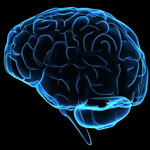 The use of minute particles as drug carriers for targeted therapy has been studied and discussed for more than 20 years. A selective accumulation of active substances in target tissues has been demonstrated for certain so-called nanocarrier systems that are administered bound to pharmaceutical drugs. Great expectations are placed on nanocarrier systems that can overcome natural barriers such as the blood-brain barrier (BBB) and transport the medication directly to the desired tissue and thus heal neurological diseases that were formerly incurable. The BBB represents the border between the circulating blood and the fluid in the central nervous system. It functions to protect the sensitive nerve cells from foreign substances and infections from the blood. Whether nanoparticles enter the central nervous system unintentionally and induce health problems is also being debated.
The use of minute particles as drug carriers for targeted therapy has been studied and discussed for more than 20 years. A selective accumulation of active substances in target tissues has been demonstrated for certain so-called nanocarrier systems that are administered bound to pharmaceutical drugs. Great expectations are placed on nanocarrier systems that can overcome natural barriers such as the blood-brain barrier (BBB) and transport the medication directly to the desired tissue and thus heal neurological diseases that were formerly incurable. The BBB represents the border between the circulating blood and the fluid in the central nervous system. It functions to protect the sensitive nerve cells from foreign substances and infections from the blood. Whether nanoparticles enter the central nervous system unintentionally and induce health problems is also being debated.
Dec 8th, 2010
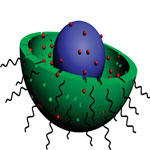 Silica nanomaterials have shown great promise for delivering anticancer and other water-insoluble drugs into human cancer cells. The high surface area, tunable pore diameter, and uniform mesoporous structure of the mesoporous silicas offer a unique advantage for loading and releasing large quantities of biomedical agents. These properties are beneficial for designing stimuli-response drug release and allow mesoporous silica nanoparticles (MSN) to be loaded with a drug. Especially MSNs with hollow and rattle structure show particularly higher drug loading efficiency because the interstitial hollow space can selectively and efficiently accommodate drug molecules. In what represents a significant progress of in vivo cancer therapy with mesoporous silica nanomaterials, researchers have demonstrated that silica nanorattles show advantages for in vivo enhancement of therapy efficacy and reducing the systematic toxicity of antitumor drugs.
Silica nanomaterials have shown great promise for delivering anticancer and other water-insoluble drugs into human cancer cells. The high surface area, tunable pore diameter, and uniform mesoporous structure of the mesoporous silicas offer a unique advantage for loading and releasing large quantities of biomedical agents. These properties are beneficial for designing stimuli-response drug release and allow mesoporous silica nanoparticles (MSN) to be loaded with a drug. Especially MSNs with hollow and rattle structure show particularly higher drug loading efficiency because the interstitial hollow space can selectively and efficiently accommodate drug molecules. In what represents a significant progress of in vivo cancer therapy with mesoporous silica nanomaterials, researchers have demonstrated that silica nanorattles show advantages for in vivo enhancement of therapy efficacy and reducing the systematic toxicity of antitumor drugs.
Dec 7th, 2010
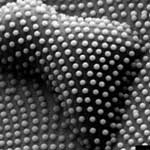 Projection photolithography is mostly limited to flat surfaces. However, many emerging areas of micro- and nanotechnology applications, be it in optics, imaging, sensors or bioengineering, increasingly require the fabrication of microscopic and nanoscopic patterns on nonplanar surfaces. Contact printing and imprinting methods can cope with certain curved surfaces but appear to be restricted to those having a constant magnitude of curvature and a large radius of curvature relative to the arc length at least in one dimension. Researchers have now demonstrated that hexagonal noncontiguously packed (HNCP) colloidal crystals trapped at the air-water interface can be directly transferred onto solid substrates to give HNCP and distorted HNCP patterns. This bottom-up method uses self-assembled nanoparticle arrays and is not limited to flat surfaces at all.
Projection photolithography is mostly limited to flat surfaces. However, many emerging areas of micro- and nanotechnology applications, be it in optics, imaging, sensors or bioengineering, increasingly require the fabrication of microscopic and nanoscopic patterns on nonplanar surfaces. Contact printing and imprinting methods can cope with certain curved surfaces but appear to be restricted to those having a constant magnitude of curvature and a large radius of curvature relative to the arc length at least in one dimension. Researchers have now demonstrated that hexagonal noncontiguously packed (HNCP) colloidal crystals trapped at the air-water interface can be directly transferred onto solid substrates to give HNCP and distorted HNCP patterns. This bottom-up method uses self-assembled nanoparticle arrays and is not limited to flat surfaces at all.
Dec 6th, 2010
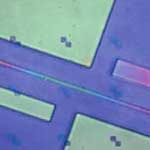 Dip-Pen Nanolithography (DPN) is a scanning probe lithography technique in which the tip of an atomic force microscope (AFM) is used to deliver molecules to a surface, allowing nanostructured surface patterning on scales of under 100 nm. This direct-write technique offers high-resolution patterning capabilities for a number of molecular and biomolecular 'inks' on a variety of substrates, such as metals, semiconductors, and monolayer functionalized surfaces. It's becoming a work-horse tool for the scientist interested in fabricating and studying soft- and hard-matter on the sub-100nm length scale.
Using DPN for fabricating graphene devices has not been previously shown. Researchers at Stanford University have now evaluated DPN as an alternative to conventional electron-beam lithography (EBL) for tailoring such devices.
Dip-Pen Nanolithography (DPN) is a scanning probe lithography technique in which the tip of an atomic force microscope (AFM) is used to deliver molecules to a surface, allowing nanostructured surface patterning on scales of under 100 nm. This direct-write technique offers high-resolution patterning capabilities for a number of molecular and biomolecular 'inks' on a variety of substrates, such as metals, semiconductors, and monolayer functionalized surfaces. It's becoming a work-horse tool for the scientist interested in fabricating and studying soft- and hard-matter on the sub-100nm length scale.
Using DPN for fabricating graphene devices has not been previously shown. Researchers at Stanford University have now evaluated DPN as an alternative to conventional electron-beam lithography (EBL) for tailoring such devices.
Dec 3rd, 2010
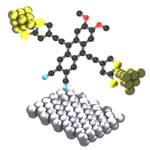 For the visionary goals of nanotechnology, functional and perhaps autonomous molecular motors will play an essential part, just like electric motors can be found in many appliances today. These nanomachines could perform functions similar to the biological molecular motors found in living cells, things like transporting and assembling molecules, or facilitating chemical reactions by pumping protons through membranes. Although applications of molecular motors are still in the future, the results of early-day studies are already spectacular: well-designed molecules or supramolecules show different kinds of motion - fueled by different driving forces such as light, heat, or chemical reactions - resulting in molecular shuttles, molecular elevators and rotating motors. A team of researchers is now proposing a conceptually new design of molecular motor based on electric field actuation and electric current detection of the rotational motion of a molecular dipole embedded in a three-terminal single-molecule device.
For the visionary goals of nanotechnology, functional and perhaps autonomous molecular motors will play an essential part, just like electric motors can be found in many appliances today. These nanomachines could perform functions similar to the biological molecular motors found in living cells, things like transporting and assembling molecules, or facilitating chemical reactions by pumping protons through membranes. Although applications of molecular motors are still in the future, the results of early-day studies are already spectacular: well-designed molecules or supramolecules show different kinds of motion - fueled by different driving forces such as light, heat, or chemical reactions - resulting in molecular shuttles, molecular elevators and rotating motors. A team of researchers is now proposing a conceptually new design of molecular motor based on electric field actuation and electric current detection of the rotational motion of a molecular dipole embedded in a three-terminal single-molecule device.
Dec 2nd, 2010
 Global warming, caused by a build-up of greenhouse gases, in particular carbon dioxide, in the atmosphere, has led to numerous proposals on how to capture and store CO2 in order to mitigate the damaging emissions from fossil fuels. Today we take a look at carbon sequestration and subsequent storage in geological formations (geosequestration) - a proposal that is already being tested on a large scale. The idea behind coal-bed geosequestration is that you inject a huge amount of carbon dioxide into deep unmined coal seams. Due to strong adsorption forces, the carbon dioxide will be adsorbed in coal. It will not be desorbed and gradually transform to solid rocks. Moreover the technology is already developed and in use for oil and gas mining. However, the fundamental problem is so-called adsorption-induced deformation of coal or any other porous material.
Global warming, caused by a build-up of greenhouse gases, in particular carbon dioxide, in the atmosphere, has led to numerous proposals on how to capture and store CO2 in order to mitigate the damaging emissions from fossil fuels. Today we take a look at carbon sequestration and subsequent storage in geological formations (geosequestration) - a proposal that is already being tested on a large scale. The idea behind coal-bed geosequestration is that you inject a huge amount of carbon dioxide into deep unmined coal seams. Due to strong adsorption forces, the carbon dioxide will be adsorbed in coal. It will not be desorbed and gradually transform to solid rocks. Moreover the technology is already developed and in use for oil and gas mining. However, the fundamental problem is so-called adsorption-induced deformation of coal or any other porous material.
Nov 30th, 2010
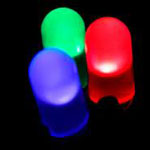 One of the many fascinating concepts in nanotechnology is the vision of molecular electronics where researchers are investigating nanostructured materials to build electronics from individual molecules. If realized, the shift in size from even the most densely packed computer chip today would be staggering. Molecular electronics aims at the fundamental understanding of charge transport through molecules and is motivated by the vision of molecular circuits to enable miniscule, powerful and energy efficient computers. A research team in Germany has now demonstrated that rigidly wired molecules can emit light under voltage bias. This result is important for fundamental science but it also adds to the molecular electronics vision an optoelectronic component, i.e. the development of optoelectronic components on the basis of single molecules.
One of the many fascinating concepts in nanotechnology is the vision of molecular electronics where researchers are investigating nanostructured materials to build electronics from individual molecules. If realized, the shift in size from even the most densely packed computer chip today would be staggering. Molecular electronics aims at the fundamental understanding of charge transport through molecules and is motivated by the vision of molecular circuits to enable miniscule, powerful and energy efficient computers. A research team in Germany has now demonstrated that rigidly wired molecules can emit light under voltage bias. This result is important for fundamental science but it also adds to the molecular electronics vision an optoelectronic component, i.e. the development of optoelectronic components on the basis of single molecules.
Nov 29th, 2010
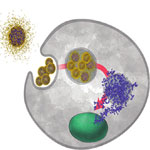 Scientists have shown that two pH response moieties - a pH solubility switch and a pH labile group - can be incorporated into the backbone of polymers which can then be formulated into dual responsive nanoparticles encapsulating small hydrophobic molecules and larger protein payloads. As nanoparticles they function akin to an AND logic gate. The beta-aminoester backbone moiety provides a pH triggered solubility switch, only when this switch is 'ON' does the ketal moiety also turn 'ON' to undergo rapid acid catalyzed hydrolysis. This system seems to be a promising vehicle for the administration of hydrophilic and hydrophobic payloads into target areas of the human body.
Scientists have shown that two pH response moieties - a pH solubility switch and a pH labile group - can be incorporated into the backbone of polymers which can then be formulated into dual responsive nanoparticles encapsulating small hydrophobic molecules and larger protein payloads. As nanoparticles they function akin to an AND logic gate. The beta-aminoester backbone moiety provides a pH triggered solubility switch, only when this switch is 'ON' does the ketal moiety also turn 'ON' to undergo rapid acid catalyzed hydrolysis. This system seems to be a promising vehicle for the administration of hydrophilic and hydrophobic payloads into target areas of the human body.
Nov 24th, 2010
 The use of minute particles as drug carriers for targeted therapy has been studied and discussed for more than 20 years. A selective accumulation of active substances in target tissues has been demonstrated for certain so-called nanocarrier systems that are administered bound to pharmaceutical drugs. Great expectations are placed on nanocarrier systems that can overcome natural barriers such as the blood-brain barrier (BBB) and transport the medication directly to the desired tissue and thus heal neurological diseases that were formerly incurable. The BBB represents the border between the circulating blood and the fluid in the central nervous system. It functions to protect the sensitive nerve cells from foreign substances and infections from the blood. Whether nanoparticles enter the central nervous system unintentionally and induce health problems is also being debated.
The use of minute particles as drug carriers for targeted therapy has been studied and discussed for more than 20 years. A selective accumulation of active substances in target tissues has been demonstrated for certain so-called nanocarrier systems that are administered bound to pharmaceutical drugs. Great expectations are placed on nanocarrier systems that can overcome natural barriers such as the blood-brain barrier (BBB) and transport the medication directly to the desired tissue and thus heal neurological diseases that were formerly incurable. The BBB represents the border between the circulating blood and the fluid in the central nervous system. It functions to protect the sensitive nerve cells from foreign substances and infections from the blood. Whether nanoparticles enter the central nervous system unintentionally and induce health problems is also being debated.
 Subscribe to our Nanotechnology Spotlight feed
Subscribe to our Nanotechnology Spotlight feed





